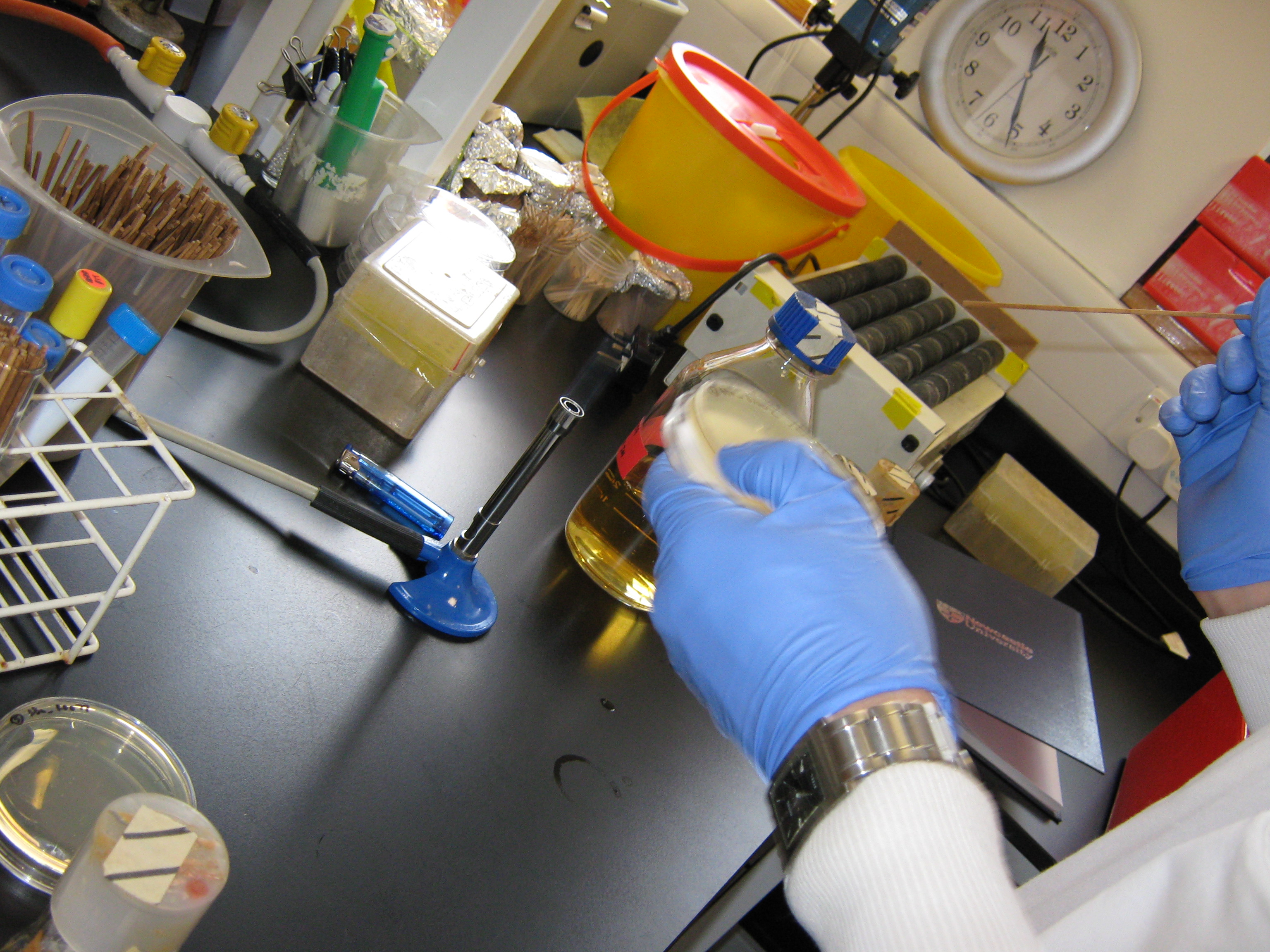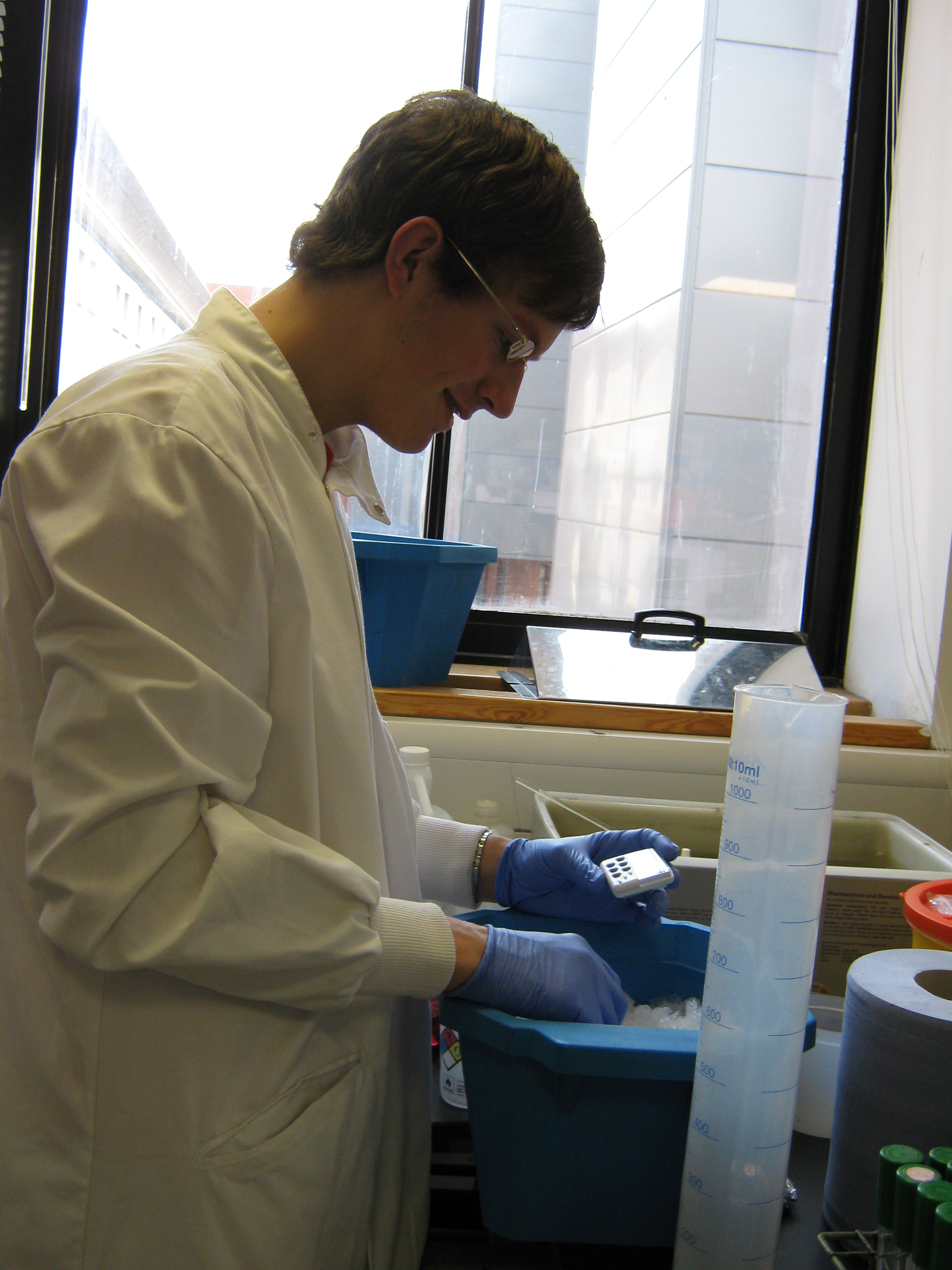Team:Newcastle/Labwork/30 July 2009
From 2009.igem.org
Formal Lab Session - 30th July 2009
Introduction
In the previous lab session, a number of different things happened. The team digested the three sets of mini-preps originating from E. coli transformed with BBa_C0056, BBa_B1002 and BBa_R0077 with EcoRI and PstI; when run on agarose gel it could be seen that the correct DNA had been transformed!. Also in the previous lab session the team attempted a second transformation of JM109 E. coli cells with BioBricks BBa_C0077 and BBa_C0076. And finally the team chose some cells to be frozen down for long term storage and grew those selected cultures up in LB solutions.
Today's lab work will involve completing the freezing down bacteria procedure. It will also involve observing the LB + Kan plates for any BBa_C0077 and BBa_C0076 transformants; if there are colonies then mini-preps will be conducted and if the transformations have failed then a final attempt at transforming E. coli cells will commence. The team will also be given a lesson by PhD student Chris Birchall on how to pour LB agar plates the way in which Dr. Phil Aldridge pours plates.
Practical Outline
These are the tasks the team need to complete by today:
- Observe BBa_C0077 and BBa_C0076 transformants on LB + kan plates
- If successful inoculate 5ml LB with colonies for mini-preps tomorrow
- If failed conduct a final set of E. coli transformations
- Prepare and pour some LB agar plates according to Dr. Phil Aldridge's method
- Freeze down cells for TPA collection
Observations
When the two LB + kan plates containing E. coli plus BBa_C0077 and E. coli plus BBa_C0076 were observed today, no colonies were found on either plate!
This presents us with a very difficult situation; we only have 1ul of DNA left to conduct our final transformations! The team took the decision to carry out one final transformation but thsi time to use the DH5-alpha E. coli cells which have worked well in previous transformations.
Procedure
Preparing and Pouring plates
Today, Chris Birchall showed us how to pour some LB + agar plates. From this we have devised a protocol, which can be seen here. A summary of the steps can be seen below:
- Made up 500ml of LB + agar solution (amount of LB + agar needed for 1 litre - 35 grams) and also prepared 500ml of distilled water into 2 x 1 litre flasks.
- Placed foil and autoclave tape on the necks of both flasks and had them autoclaved for 30 minutes.
- The LB solution was allowed to cool by sitting on bench whereas distilled water was allowed to cool in tub of cold water.
- Once the LB solution had cooled to a hot but holdable temperature, the two solutions were added to each other; the water was poured into the flask of LB solution and the LB solution was then poured back into the flask (which held the distilled water originally). This was all done under aseptic conditions.
- 5ml of antibiotic (ampicillin) was added to the flask. The LB + agar solution was then poured into a stack of plates under aseptic conditions. The plates were left on the bench surface to cool and solidify.
This procedure was carried out three times so 3 litres of LB + agar solution was made. 1 litre consisted of LB + agar, 1 litre consisted of LB + amp and 1 litre consisted of LB + kan solution.
Freezing Strains for TPA collection
To carry out the remainder of the freezing cells procedure, Phil Aldridge's freezing cells protocol was used. Here is what happened:
- Twelve screw cap tubes were taken and placed in rack as 2 sets of 6 tubes. The two sets will serve as duplicates - one set of the six tubes will be stored in Dr. Aldridge's -80C freezer whereas the second set of six tubes will be stored in a back-up -80C freezer.
- The tubes were labelled in pairs according to the strain's assigned TPA number.
- 150ul of DMSO solution was added to each of the 12 tubes under aseptic conditions.
- 1.5ml of each culture was placed into one tube in both sets of tubes (one tube for Phil's freezer and one tube for the backup freezer) according to the labelling. The cultures were mixed by pipettes under aseptic conditions.
- The first set of six tubes were then placed in the -80C freezer in Dr. Aldridge's lab and the duplicates placed in the -80C freezer in a different location.
Transforming E. coli with BBa_C0077 and BBa_C0076
The decision was taken to abandon transformations in JM109 cells and instead to use DH5-alpha E. coli cells for transforming with BBa_C0077 and BBa_C0076.
This meant that we used Dr. Aldridge's Transformation protocol to carry out this procedure. There were a few changes to the protocol:
- Step 4 - the team are adding the remaining 1ul of BioBrick DNA (BBa_C0077 and BBa_C0076).
- Steps 2 and 5 - the waiting times were changed from 30 minutes to 15 minutes.
- Step 9 - the team plated out 50ul of each set of E. coli transformants onto LB plates.
- Extra Step - the team then spun down the remainder of the two sets of E. coli cells and resuspended them each into 200ul fresh LB solution (under aseptic conditions). These were then all plated on LB+kan plates.
The plates, which were appropriately labelled, were then stored in the 37C incubator for overnight growth.
|
| |||||||||||||||||||||||||||||||||||||||||||||||||||||||||||||||||||||||||||||||||||||||||||||||||
|
| |||||||||||||||||||||||||||||||||||||||||||||||||||||||||||||||||||||||||||||||||||||||||||||
News
Events
- 20 – 21 June 2009 - Europe workshop (London)
- 23 – 24 June 2009 - UK iGEM meetup (Edinburgh)
- 23 October Practice Presentation (Newcastle)
- 23 October T-shirts are ready
- 27 October Practice Presentation (Sunderland)
- 27 October Poster is ready
- 30 October – 2 November 2009 - Jamboree (Boston)
Social Net
 "
"





